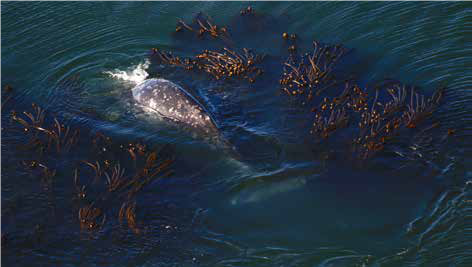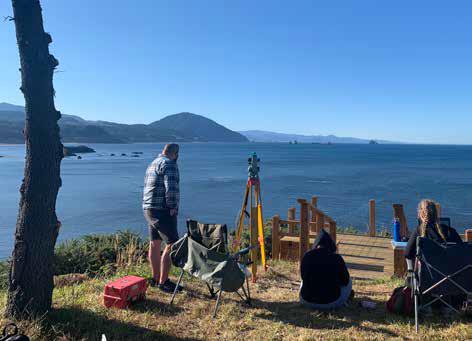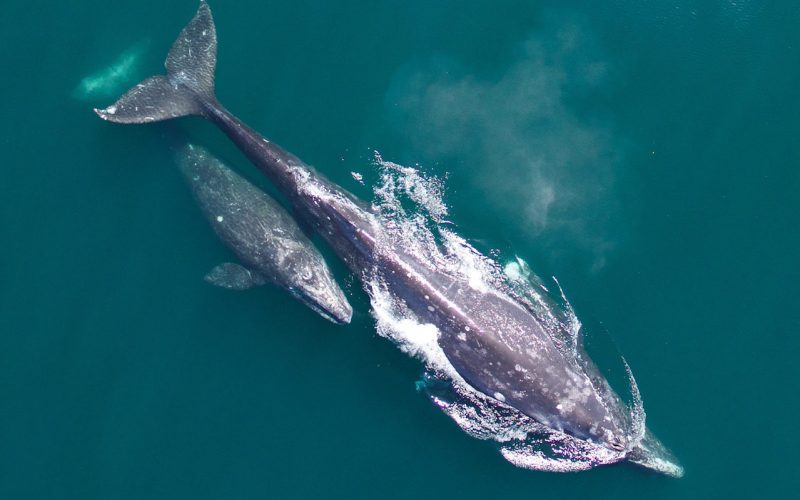STORY BY JENNIFER GERVAIS
Gray whales travel twice a year between their summer feeding grounds in Alaska and the warm lagoons of the Baja Peninsula, passing close to the Oregon coast along the way.
They pass in large numbers during the darkest days of December, prompting crowds to brave the winter wind and storms. They pass again in the spring, and some even stay to enjoy summer along the Oregon coast.
People stand on promontories of rock and exposed shoreline, scanning the sea for the telltale plumes of mist that the travelers leave behind. Despite the cold and wet or wind, the people watching behave like all parade bystanders do, calling out, pointing and waving, and clearly enjoying themselves. Unlike most parades, however, the participants in the parade itself seem either unaware or utterly uninterested in the spectators.
Gray whales have an entirely different agenda than their delighted observers do. Gray whales are baleen whales, close cousins of the mighty blue whales. They are much smaller cousins, reaching a bit more than half the length and roughly one-fifth of the weight. However, they share the remarkable plates that sweep down like rigid, bristly curtains from the upper jaw in place of teeth. Gray whales spend most of their lives within sight of land, making them far more accessible to human observation than other species of whale. Their migrations also take them right along Oregon’s coast.
The gray whale migration is one of the longest annual migrations on earth. Every year, they follow a route that takes them from their rich summer feeding grounds, in the Bering and Chukchi seas between Siberia and Alaska, south to the warm, shallow lagoons of the western Baja Peninsula in Mexico, 5,000 miles away. During the entire journey, they remain within sight of land, offering many opportunities for people to observe them. Off the Oregon coast, the whale’s northward migration takes place in spring from March to May. The southward migration is at its peak in late December and early January. However, the gray whale’s year may include the Oregon coast in all four seasons.
The Journey Begins
Gray whales are born in late winter, in the warmer waters off the coast of the Baja peninsula of Mexico. There, the expectant cows move into salty, shallow lagoons to give birth. The newborns are roughly 15 feet long and weigh about 2,000 pounds. They have neither the blubber—the layer of insulating fat—that their mothers have, nor the 400 pounds of whale lice and barnacles that will eventually decorate their skin.
The mother-calf pairs remain in warmer waters for an average of three weeks, until the young whales put on a layer of blubber from their mothers’ rich milk. The pairs remain physically very close together, murmuring to each other in a series of unique vocalizations that scientists have named “motherese.”
“On that first journey north, the mother-calf pairs remain very close together, often hugging the shoreline even more
than single gray whales do.”
The other adult whales arrive in Baja only to breed. Cows whose calves have weaned a few months before mate again, and the newly pregnant cows and bulls quickly reverse course. They may remain in the breeding area for as little as a few days before heading north again while the newborn calves are still fattening for the journey. Thus, you will see a long procession of gray whales off the Oregon coast in spring, starting with the bulls and cows without calves in March and April, then by early May, the mothers with calves. It takes a full year to carry a baby gray whale to term, so the whales give birth every other year.
Gray whales do not form tight social networks like orcas do, although they will migrate together in loosely affiliated groups. The only strong bond exists between mother and offspring until the baby is old enough to forage and survive on its own, at the end of its first summer when it is roughly nine months of age.
On that first journey north, the mother-calf pairs remain very close together, often hugging the shoreline even more than single gray whales do. They can be identified from their double blows as they surface together. The mother whales may be using the sounds of crashing surf to help hide them from orcas, which are their greatest natural threat.
Gray Whale “Fast-Food”
Although gray whales will stop for a quick bite on their migrations, the vast majority of the calories a gray whale needs on an annual basis are obtained during an intense four to six months of summer feeding activity. During that time, a typical adult gray whale will eat over 2,500 pounds of food per day.
That food must not only nourish the 49-foot-long, 90,000-pound adult, but allow it to put on the blubber that will fuel the journey south in the fall. For the pregnant cows, that blubber will also nourish her baby after birth and during the long trek back to the northern feeding grounds. Calf survival is strongly driven by the cows’ ability to gain weight the year before.

Gray whales’ menus are quite varied. Unlike other baleen whales, gray whales will suction fine mucky sediment from the coastal seafloor, sieving it through their baleen plates to capture the small crustaceans that live there. These tiny crab cousins form dense clusters just underneath the surface of the sediments. This style of feeding leaves the seafloor scarred with pits that resemble shallow bathtubs.
The newly created habitat offers space for colonizing marine life, and the sediment plumes the whales spit out help recycle nutrients into the water column. Gray whales in the Bering and Chukchi Seas suspend twice as much sediment in the water column during their summer dining activities than the Yukon River deposits for the entire year. In addition, the whales feed opportunistic dinner guests in the form of seabirds of many species, drawn to the mud plumes in the water column to seek any floating dead or dying prey. This food source may be particularly valuable to arctic seabirds.
Gray whales also feed more like the rest of the baleen whales, by lunging open-mouthed through swimming swarms of crustaceans either just above the bottom or going after small forage fish in the water column. They’ve even been seen skimming the sea’s surface for crab larvae. The variety of dinner menus and venues makes it less likely that a gray whale will go hungry.
In late fall, ice begins to intrude on the northernmost whales’ feeding grounds. As they begin moving south, the migration picks up individuals who did not travel as far north. Some whales spend their summers as far south as Point St. George in northern California, whereas others move slowly along the Oregon and Washington coastlines or summer off Vancouver Island. Thus, gray whales may be seen at any point in the summer off the Oregon coast. It is worth a scan any time you find yourself with a good view of the ocean on a calm day when you could see the whales’ blows.
Threats to Gray Whales
Gray whales have been a part of Oregon’s coastline for thousands of years, but changing conditions pose challenges to them. Although gray whales in the eastern Pacific have recovered from the whaling that ended a century ago, they are at risk of being struck by boats or ships, or becoming entangled in fishing gear.
As ocean conditions shift with climate change, the abundant food resources in the Arctic may fail, requiring the gray whales to find new places to feed. Changing ice conditions in the Arctic may disrupt the cues the whales use to know when to head south in order to give birth in the warm, safe lagoons.
However, gray whales have survived many changes and challenges through the millennia, and if we care enough about our fellow travelers, they will continue to delight us with their stately parades along our coastline.
Oregon’s Summer Whales

Staff and students at Oregon State University’s Marine Mammal Institute perform research on various marine animals, including gray whales that spend the summer off the Oregon Coast. Research in Port Orford is focused on the foraging ecology of gray whales. “We track whales from shore and are concurrently collecting zooplankton prey samples, says project co-investigator Lisa Hildebrand. That research, says Hildebrand, will help scientists determine what gray whales are feeding on and where they are finding prey. For more information about OSU’s gray whale research and activities, visit MMI’s blog.
This story was published in the Fall/Winter 2020 issue of Oregon Coast magazine.




